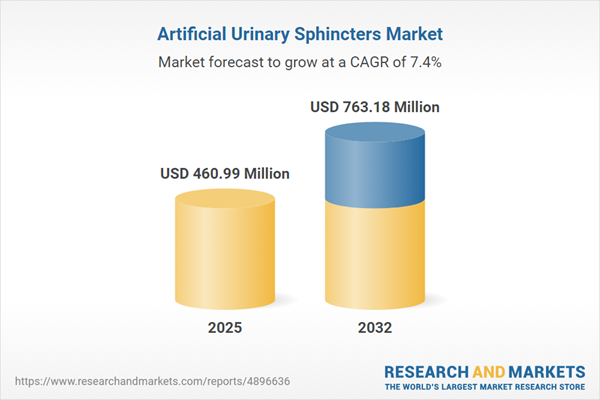Speak directly to the analyst to clarify any post sales queries you may have.
Senior decision-makers operating within the artificial urinary sphincters market face complex responsibilities as they guide business agendas across evolving clinical, regulatory, and innovation priorities. Their leadership shapes performance and enables organizations to respond proactively to global healthcare shifts.
Market Snapshot: Artificial Urinary Sphincters Industry Trends
The artificial urinary sphincters market continues to advance, with current market size estimated at USD 429.53 million in 2024 and a projected increase to USD 763.18 million by 2032, signifying a 7.44% CAGR over the period. Growth is attributable to demographic changes, particularly an aging population worldwide, which raises clinical attention to urological health solutions. Ongoing improvements in device design, use of advanced biomaterials, and integration of cutting-edge digital health technologies are actively redefining sector performance. Enhanced research capacities, streamlined product development, and evolving regulatory responses collectively position industry players to compete and adapt across diversified global markets.
Scope & Segmentation of the Artificial Urinary Sphincters Market
- Device Types: The market includes single-component, two-component, and three-component systems, offering providers varied intervention options for customized patient care and enabling higher precision and procedural efficiency.
- End User Settings: Artificial urinary sphincters are deployed in ambulatory surgical centers, private clinics, specialized urology practices, and hospitals, ensuring flexible and scalable integration across healthcare environments.
- Distribution Channels: Devices reach practitioners via direct manufacturer sales, OEM partnerships, third-party distributors, and online channels, each supporting robust supply chains and broadening global market access.
- Gender-Based Considerations: As device designs evolve for both male and female patients, accompanying clinician training and patient education initiatives drive safer procedures and greater adoption across patient groups.
- Clinical Applications: Addressing needs such as stress urinary incontinence and neurogenic bladder, artificial urinary sphincters enable improved quality of life and support consistent treatment outcomes.
- Regional Coverage: The Americas, Europe, Asia-Pacific, and the Middle East and Africa all present distinct regulatory and competitive dynamics. Localized approaches to compliance, risk assessment, and market entry are required for success in these territories.
- Leading Companies: Major market participants—including Boston Scientific Corporation, Promedon S.A., Zephyr Surgical Implants AG, Rigicon Inc., Uromedical AG, and Coloplast A/S—prioritize differentiated product strategies and extensive international reach.
Key Takeaways for Senior Decision-Makers
- Digital health technologies are enhancing care coordination and enabling the use of real-time patient data for sound clinical decisions across various provider networks.
- The adoption of minimally invasive and robotic-assisted procedures is increasing, and these approaches are establishing higher standards for patient outcomes and procedural reliability.
- Procurement strategies that emphasize supplier variety and lifecycle management help sustain operations, shield against supply disruptions, and support cost management objectives.
- Partnerships with adjacent health sectors, combined with innovative material use, are broadening device safety parameters and reaching previously underserved patient segments.
- Structured clinician training and organization-wide support are vital for the effective introduction and sustainable integration of new device technologies into practice.
Tariff Impact: Navigating Regulatory Shifts
Anticipated U.S. tariffs scheduled for 2025 are prompting sector manufacturers to fortify their procurement operations and diversify supplier networks. Forward-thinking companies are actively fostering collaboration across procurement, logistics, and compliance teams to ensure a steady product supply and manage risk in a shifting regulatory climate. Adapting business practices to these regulatory changes will be essential to maintaining supply chain integrity and operational continuity.
Methodology & Data Sources
The market analysis is built upon primary interviews with clinicians, procurement managers, and health economists. Extensive market research procedures and validated dataset analysis guarantee thoroughly vetted insights tailored for the artificial urinary sphincters market’s strategic decision-makers.
Why This Report Matters
- Empowers executives to lead innovation programs, plan successful market entry, and drive geographic expansion based on relevant and actionable intelligence for the artificial urinary sphincters market.
- Supplies comprehensive frameworks to guide technology adoption, optimize supply chain performance, and ensure ongoing regulatory compliance in dynamic healthcare settings.
- Supports organizations in enhancing patient care quality, strengthening business resilience, and maintaining competitive positioning within changing regulatory and market environments.
Conclusion
This report provides senior decision-makers with the insights needed for effective strategy alignment, operational improvement, and collaborative growth, ensuring a future-ready approach as the artificial urinary sphincters market evolves.
Additional Product Information:
- Purchase of this report includes 1 year online access with quarterly updates.
- This report can be updated on request. Please contact our Customer Experience team using the Ask a Question widget on our website.
Table of Contents
3. Executive Summary
4. Market Overview
7. Cumulative Impact of Artificial Intelligence 2025
Companies Mentioned
The companies profiled in this Artificial Urinary Sphincters market report include:- Boston Scientific Corporation
- Promedon S.A.
- Zephyr Surgical Implants AG
- Rigicon Inc.
- Uromedical AG
- Coloplast A/S
Table Information
| Report Attribute | Details |
|---|---|
| No. of Pages | 180 |
| Published | November 2025 |
| Forecast Period | 2025 - 2032 |
| Estimated Market Value ( USD | $ 460.99 Million |
| Forecasted Market Value ( USD | $ 763.18 Million |
| Compound Annual Growth Rate | 7.4% |
| Regions Covered | Global |
| No. of Companies Mentioned | 7 |









